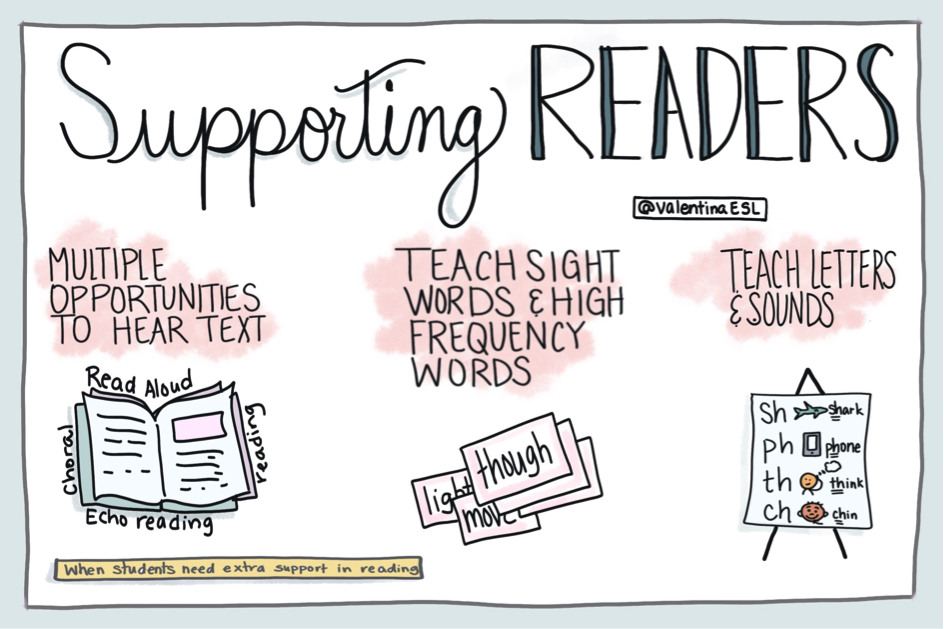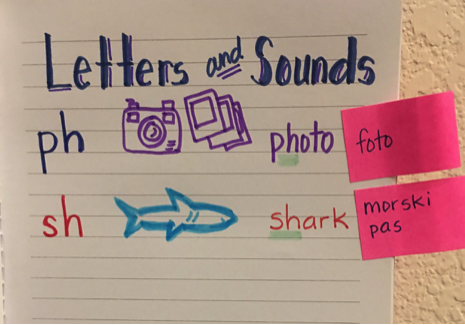What If My Middle Level EL Student Can’t Read?
A MiddleWeb Blog

Sometimes middle grades students who grapple with reading hide their struggles behind a mask of misbehavior to save face. In order to avoid embarrassment from their peers, it’s easier to misbehave than to look “not smart.”
The middle grades are sensitive years for kids. They are hyper focused on what their friends think of them. Add to that being an English learner and on top of that a struggling reader, and you might have some challenges.
Whether the students you work with are English learners or native English speakers, the strategies below will provide support for students who are striving to read text on grade level.
Three Methods to Support Readers
1. Provide students with multiple opportunities to hear text
English learners in the middle grades who struggle with reading will benefit from hearing examples of fluent reading frequently. Keep in mind that as you read aloud to students, you are their model for what an expert reader sounds like. Read with expression, be mindful of your phrasing, and take note of the rate at which you read. A read-aloud can take the form of a picture book, a chapter from a book, a poem, a brochure, a passage about history or science, or even a math problem.
When conducting a read aloud, select a text that is relevant and engaging for your group of students. Project the piece so all students can see what you are reading, or provide them each with a copy. As you read it aloud, make your reading strategies visible to the students. Model by thinking aloud your thoughts. Providing opportunities for students to turn and talk with a partner, draw on paper, or act out a scene increases comprehension for English learners.
Another way to involve students in the reading is through echo reading. Echo reading helps students to improve fluency in a safe, risk free setting. Rather than calling on one student at a time to read aloud, the teacher reads a sentence and acts as a model for phrasing and rate. Then students repeat the same sentence, trying to mimic the same phrasing and rate. This technique is highly effective for English learners who are newcomers or at the beginning, entering/emerging levels of language development.
In addition to echo reading, choral reading can provide students with an opportunity to practice reading in a low risk setting while improving fluency. This method is similar to echo reading, but instead of the teacher reading first and then students repeating, everyone reads the same section of text together at the same time.
You might consider selecting a key section of the text to read chorally to highlight a specific feature of the text. Another suggestion is to divide the class in half and assign certain parts of the text to each half. This is especially exciting if the text has dialogue and characters. Essentially, you can create a mini version of a reader’s theater experience.
2. Teach students about sight words and high frequency words
Students benefit from being extremely familiar with sight words and high frequency words. These words make up about 50% of the words they see in print. If they can read them with automaticity, they will be more comfortable with reading and be better at comprehending. Students need to be able to read the sight words and high frequency words quickly.
Take a moment to confer with students who are struggling with reading and conduct an inventory of the sight words and high frequency words that they can read quickly. While conferring with students individually, select a set of about 10 words to assess. Decide on a system for practicing the words they can’t yet read automatically. Different methods I’ve seen are notebooks where students recorded the words they needed to practice or a ring/box of index cards.
English learners in the middle grades who lack a grasp of sight words or high frequency words may either be newcomers who are at the beginning or entering stages of language development in English – or they may be students who have been in the United States for several years but haven’t had enough practice with reading at their independent level.
[Browse Larry Ferlazzo’s “sight words” category for resources.]
They may need direct instruction about sight words. They may need to be told that these words are not words that need to be sounded out. Either way, English learners who need practice with sight words will benefit from time to practice reading books in the classroom with your support and guidance. They may need you to help them select books that are just right for them: books that engage and challenge them as readers, yet are compelling and relevant enough to keep them motivated.
3. Teach students about letters and sounds
English learners who are immigrants, especially during the middle grades, may come to the US with little or no experience with the English language. Take time to assess what students know about the English alphabet. Confer with students individually and ask them to name the letters and their sounds.
Students from other countries may know some or most of the letters and sounds but are unfamiliar with a few. You can take the opportunity to quickly share with students the names and sounds of letters that are new to them. This does not need to be a long lesson, just a few targeted minutes to directly teach. Leave students with an artifact such as a sticky note with the topics discussed. (see example)
If students are familiar with letters and sounds, move to consonant digraphs, blends, and vowel teams. Show students the letter combinations and brainstorm words that have the combinations. Newcomer students may need to translate words into their native language or use a visual as a support.
Keep in mind when asking English learners to read, stay away from questions like, “Does that sound right?” For many English learners, this question may not be fair. To know if something sounds right, I have to have developed an ear for it. Some English learners have not yet been exposed to English language structures enough to have developed that ear to know if it sounds right.
Put yourself in their position. Imagine that you are learning Serbian. You read a sentence. “Trava raste i drva puno lisce.” Now the teacher asks you if it sounds right. Would you really know, or would you be trying to guess based on how he/she asked you?
Explicitly teaching about letters and sounds is especially important for students whose primary language is not Latin based or whose language is based on symbols. When students come to us knowing how to read in their native language, we are not necessarily teaching them what reading is and how to do it again. We are unlocking the new language.
 Starting points
Starting points
The instructional methods here are not everything that can help struggling readers. This is a starting point. All students including English learners need to feel encouraged, supported, and confident in themselves. Throughout all that we do with them, we have to strive to make them believe that they can and will improve and grow as readers.
Try out some of these suggestions and let us know what works for your students. Are there other techniques you have found that support English learners who struggle with reading? Please share!






































Appreciate your insights and writing. Been following you on twitter, but want to subscribe to your blog as well. I teach both newcomers and LTELs in middle school in Berkeley, Ca.
Do you recommend a book I can purchase on this?